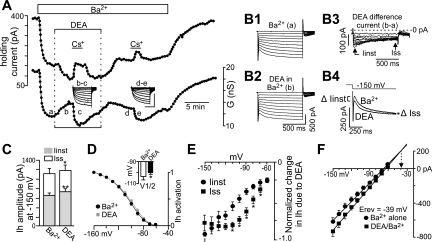Fig. 7.
NO increases the instantaneous (Iinst) and time-dependent (Iss) components of Ih. A: traces of holding current and conductance show that in Ba2+ (2 mM) to block background K+ channels, exposure to DEA (20 μM) decreased outward current and increased conductance. In addition, DEA increased effects of Cs+ on holding current and conductance by 55% and 58% (n = 9), indicating that DEA increased a Cs+-sensitive inward current. Inset: Cs+-sensitive difference currents, generated by subtracting current responses to hyperpolarizing voltage steps recorded at the indicated times a–e (scale bars are 500 ms and 500 pA). B1–B3: current responses to hyperpolarizing voltage steps recorded in Ba2+ alone (B1), Ba2+ plus DEA (B2), and the corresponding difference current (B3) show that DEA increased both Iinst and Iss, but at more hyperpolarized potentials NO increased Iinst to a greater extent than Iss. This can also be seen in superimposed current responses to a −150-mV step in Ba2+ alone and Ba2+ plus DEA (B4). C: average Ih amplitude plotted as Iinst and Iss evoked by a −150-mV step in Ba2+ alone (n = 8) and Ba2+ plus DEA (n = 8). *P ≤ 0.05; **P < 0.001. D: Ih activation curves in Ba2+ alone and in Ba2+ plus DEA. Inset: DEA caused a small (3 mV) depolarizing shift in Ih activation. E: average (n = 8) I-V relationships of the NO-sensitive Iinst and Iss currents. *P ≤ 0.05. ‡P < 0.05 designates the potential at which Iinst is greater than Iss. F: average (n = 8) I-V relationships of Iinst in Ba2+ alone and in Ba2+ plus DEA. The data were fitted with linear regression, and the extrapolated intersection of the regression lines is near the reversal potential (Erev) for Ih.

